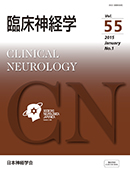Volume 55, Issue 12
Displaying 1-15 of 15 articles from this issue
- |<
- <
- 1
- >
- >|
Original Article
-
2015 Volume 55 Issue 12 Pages 889-896
Published: 2015
Released on J-STAGE: December 23, 2015
Advance online publication: October 28, 2015Download PDF (1370K)
Case Reports
-
2015 Volume 55 Issue 12 Pages 897-903
Published: 2015
Released on J-STAGE: December 23, 2015
Advance online publication: October 28, 2015Download PDF (1467K) -
2015 Volume 55 Issue 12 Pages 904-908
Published: 2015
Released on J-STAGE: December 23, 2015
Advance online publication: October 28, 2015Download PDF (496K) -
2015 Volume 55 Issue 12 Pages 909-913
Published: 2015
Released on J-STAGE: December 23, 2015
Advance online publication: October 28, 2015Download PDF (557K) -
2015 Volume 55 Issue 12 Pages 914-920
Published: 2015
Released on J-STAGE: December 23, 2015
Advance online publication: October 28, 2015Download PDF (804K) -
2015 Volume 55 Issue 12 Pages 921-925
Published: 2015
Released on J-STAGE: December 23, 2015
Advance online publication: October 28, 2015Download PDF (638K) -
2015 Volume 55 Issue 12 Pages 926-931
Published: 2015
Released on J-STAGE: December 23, 2015
Advance online publication: October 28, 2015Download PDF (559K) -
2015 Volume 55 Issue 12 Pages 932-935
Published: 2015
Released on J-STAGE: December 23, 2015
Advance online publication: October 28, 2015Download PDF (506K)
Brief Clinical Notes
-
2015 Volume 55 Issue 12 Pages 936-939
Published: 2015
Released on J-STAGE: December 23, 2015
Advance online publication: October 28, 2015Download PDF (469K) -
2015 Volume 55 Issue 12 Pages 940-942
Published: 2015
Released on J-STAGE: December 23, 2015
Advance online publication: October 28, 2015Download PDF (410K)
Proceedings of the Regional Meeting
-
2015 Volume 55 Issue 12 Pages 943-949
Published: 2015
Released on J-STAGE: December 23, 2015
Download PDF (1294K) -
2015 Volume 55 Issue 12 Pages 950-955
Published: 2015
Released on J-STAGE: December 23, 2015
Download PDF (1140K)
Notice
-
2015 Volume 55 Issue 12 Pages 956-957
Published: 2015
Released on J-STAGE: December 23, 2015
Download PDF (133K) -
2015 Volume 55 Issue 12 Pages 958-963
Published: 2015
Released on J-STAGE: December 23, 2015
Download PDF (407K)
Editor’ Note
-
2015 Volume 55 Issue 12 Pages 964
Published: 2015
Released on J-STAGE: December 23, 2015
Download PDF (161K)
- |<
- <
- 1
- >
- >|
